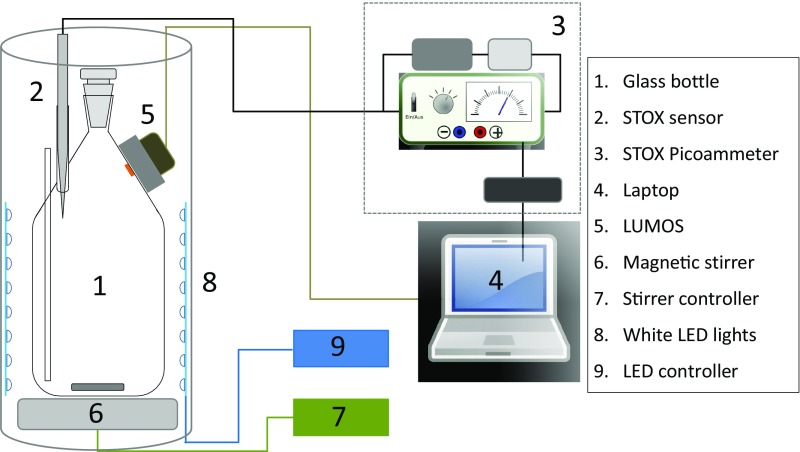Fig. S5.
Experimental setup for measurement of O2 production/consumption. Glass bottle (labeled as 1) with a volume of 1160 mL. A series of modifications were done to a standard Schott–Duran glass bottle including (i) the insertion of a long open glass tube (internal diameter 2.5 mm) for pressure compensation and for the injection of calibration solution or tracers; (ii) the addition of a short 8.1-mm (inner diameter) glass tube for insertion of the STOX sensor (labeled as 2) or a solid 8-mm glass bar if STOX sensors were not used; (iii) a modification of the bottle neck to accommodate a ground glass stopper (internal diameter 12 mm) so that the inner part of the bottle could be accessed; and (iv) insertion of a sensing dot for optode-based measurements that was glued onto the inner surface of the bottle, whereas the reading device (LUMOS) was positioned on the outside, held by a PVC frame glued to the bottle. STOX sensors (labeled as 2) were connected to a picoammeter (labeled as 3) equipped with an external battery and a switch for the periodic polarization of the front guard of the sensor. The signal from the picoammeter was fed into an A/D converter connected to a laptop (labeled as 4). The LUMOS (labeled as 5) device was directly connected to the laptop. A magnetic stirrer (labeled as 6) and a controller (labeled as 7) ensured homogeneous mixing of the water in the bottle by a glass coated magnet. A white LED system surrounded the bottle (labeled as 8) to ensure a homogeneous light distribution. The light intensity was modulated by an external controller (labeled as 9), and the light spectrum of the SCM was simulated by coating the LEDs with a Marine Blue filter (LEE Filters). The LEDs were installed within a nontransparent PVC tube. The incubation bottles and associated lighting and stirring equipment were immersed into a water bath held at the in situ temperature (14 °C).

